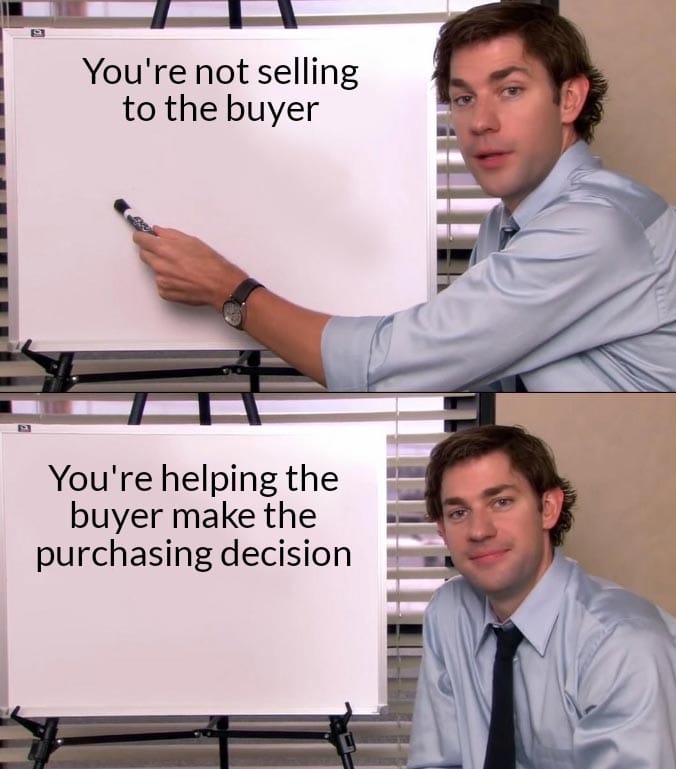A Beginner's Guide to Buyer Enablement
People are either over-the-top Olivia with a spending problem or can't-decide-for-his-life Charlie. Olivia loves to spend and is neck-deep in linen, has shaving cream stocked up for the next 8 years, is never out of crackers or jam (god forbid they run out), and has 18 types of juices.
The latter would rather be crippled by indecisiveness than make a wrong choice.
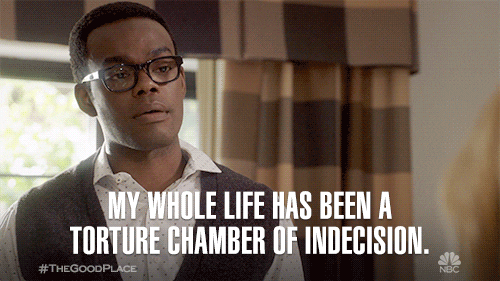
But capitalism has found a way to sell to both. To Olivia, by giving her a variety of options and flavours with the same ingredients, but disguised (shampoos, we see you) and to Charlie, by appealing through the convenience of no questions asked easy returns policies.
Wherever you lie on the buyer spectrum, everyone agrees selling is an art.
And yet, no one likes being sold to. How then, do you sell?
First, let's look at why and how people buy.
Why We Buy
When you dig into the reasons why people truly buy, you will realize that there isn't much reasoning behind a lot of our actions. It isn’t always rational.
How many times have you found yourself buying something extra (read: something you do not need and is probably overpriced), all because you didn't meet the minimum requirements to avail free shipping and you weren't about to spend $9 on shipping?

Or, because you needed it to compliment a previous purchase that was just as unnecessary?
Or, because you're having a bad day, and shiny new shoes and a few tubs of choco chip ice cream are the only things that will give you the will to walk into that godforsaken cubicle and cry on company time?
There are 3 main reasons why we buy the things we buy
1. Emotional
Why do you have the squishy stress ball? Why did you buy a soft toy at 32? The tickets to the Baseball game, worth a week's salary, or those yoga pants when you haven't been to the gym in 8 years.
You buy these things in advance without having any plan on how you're going to use them, hoping they trigger a better lifestyle, habit, or at least provide entertainment.
Yes, it includes impulse purchases, the 3 AM money spent on handmade leather notebooks or the Xbox you bought for old times sake.
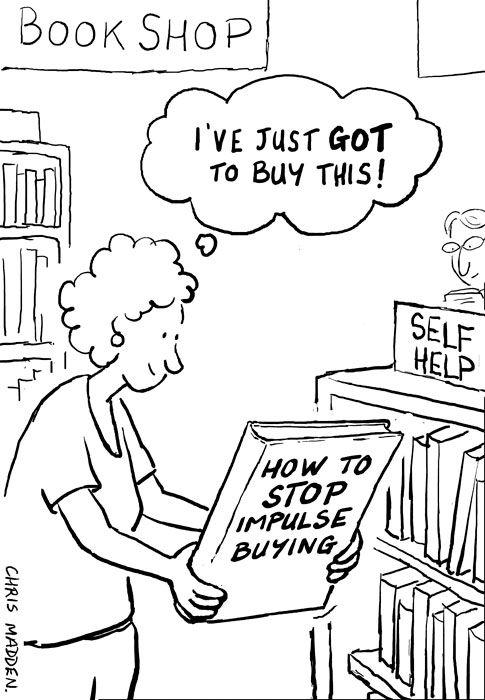
2. Social
We'd all like to think we're not severely affected by social class and prejudice. Why then do we feel so conscious in settings where we're surrounded by strangers for a long period?
A lot of consumer purchases are based on decisions made through societal expectations and perceptions. Why else would luxury sell?
This also includes why people prefer to buy from ethical stores and companies that stand for something bigger (considering it's just as convenient as ordering it from Amazon if not more).
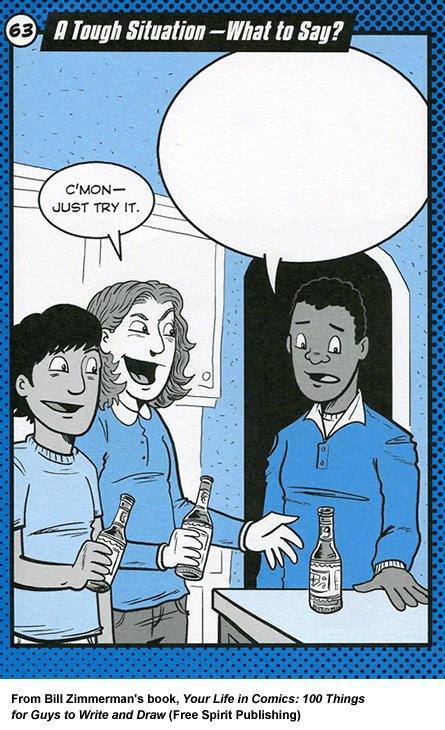
3. Functional
People buy stuff to make their lives easier. Chopping boards, sharper knives, longer-lasting deodorant (even if it clogs your pores), you name it.
Some save time, some effort, and some, both (now isn't that delightful). You also pay a premium for it, but most of us are willing to. A lot of people buy things that do them good or provide knowledge. Books, Patreon communities, courses.
Why and how people buy could also be based on where their needs fall on Maslow's need hierarchy.
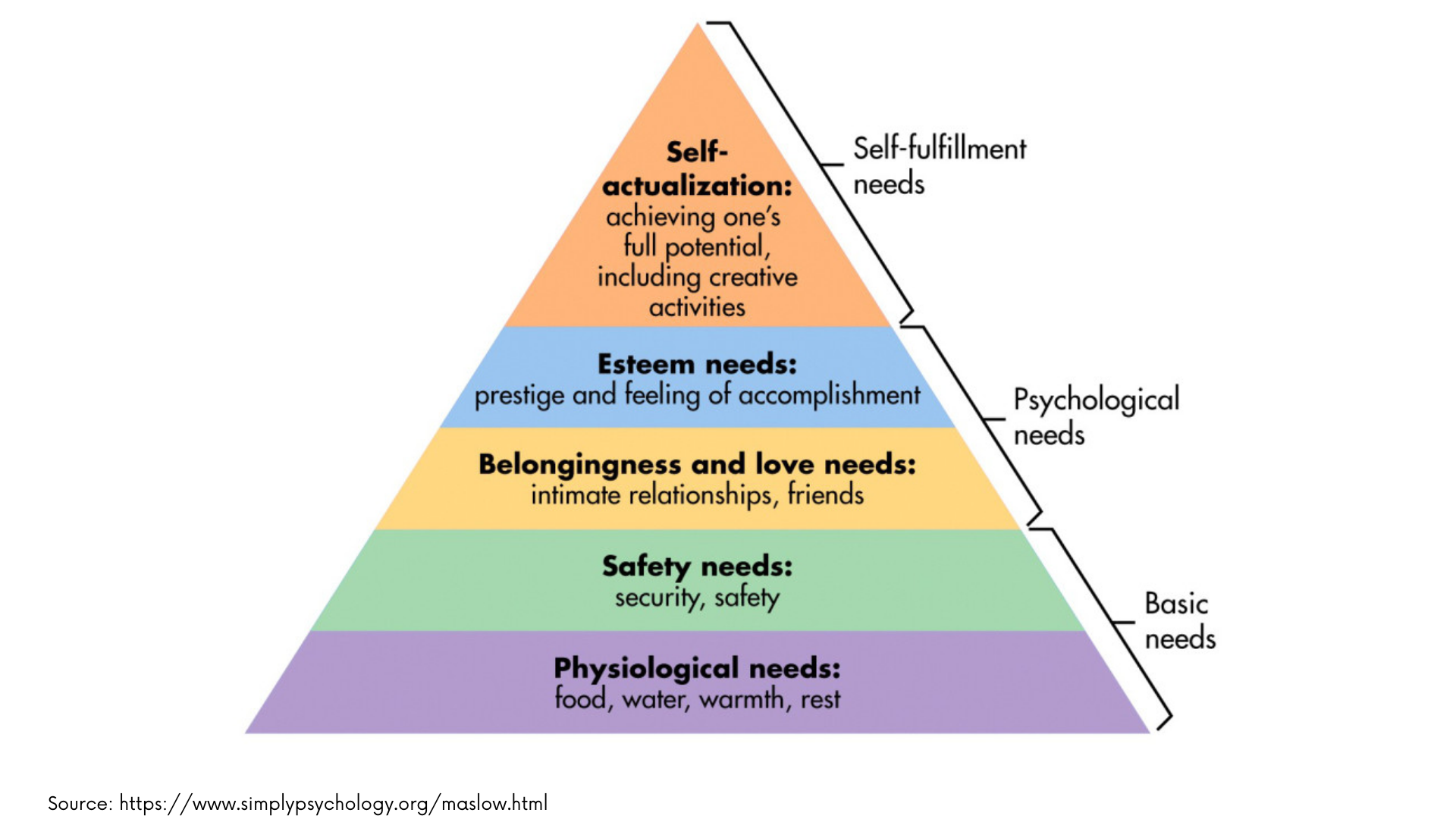
In a B2C setting, the decision-making process is generally a simple, quick, and impulsive one. While in a B2B setting, it's complex, budget restrictive, and well thought out. In a lot of ways, B2B purchases are investments and have consequences.
But ultimately, convenience wins. That's the entire essence of the buying decision. One of the biggest reasons why 3 AM bad purchase decisions are oh-so-easy to make, is because it's made that easy.
The Buyer’s Journey
Here’s how a typical buying journey of a buyer looks like:

These are all the different stages a buyer goes through before making a purchase.
Awareness
The buyer realises the problem they’re facing and is looking to identify the root cause. It is also called the “problem aware” stage.
Consideration
The buyer has identified their problems and is exploring possible solutions. Also known as the spend-inconsiderate-amounts-of-time-to-find-a-fix stage.
Decision
The buyer has zeroed in on the fix, knows what needs to be done and is in between shortlisting a vendor and making the purchase decision.
Shifts in the Buyer’s Journey
Think of the time you were at your local McDonald’s and had a tough time choosing between the Big Mac and the Quarter-Pounder or the 400 other options on the menu.
Or the time you were yelled at by customers waiting in line at Starbucks for not being able to decide how you wanted your coffee.
Even something as simple as buying a new mobile device on Amazon can be anxiety-inducing simply because of all the different options available.
This information overload and the explosion of choice availability have made buying a complex process often sending you into a tizzy on account of indecision.
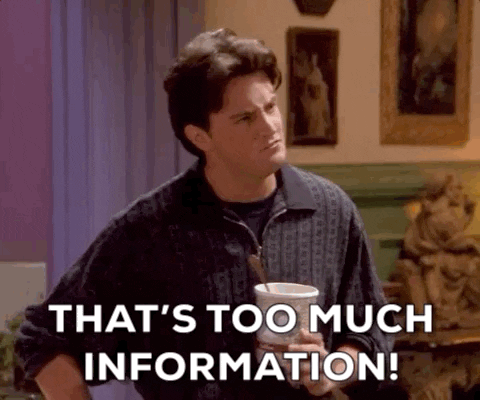
Things aren’t so different on the B2B side. A B2B Buyer Behaviour Study by Demand Gen shows that B2B buyers are rapidly showcasing consumer-like behaviour.
77% of B2B buyers found the buying process extremely difficult to navigate and complex.
Only 17% of buying time involves meeting with potential suppliers. And when there are multiple potential suppliers, the time spent with sales reps is only 5% of the total buying time.
So if you’re still using conventional selling techniques with your customers, NEWSFLASH: It’s unlikely to work.
What Is Buyer Enablement?
Given the complexity of the buying process, it becomes essential to look at sales and marketing from the buyer’s perspective and simplify the process and help them make purchases.
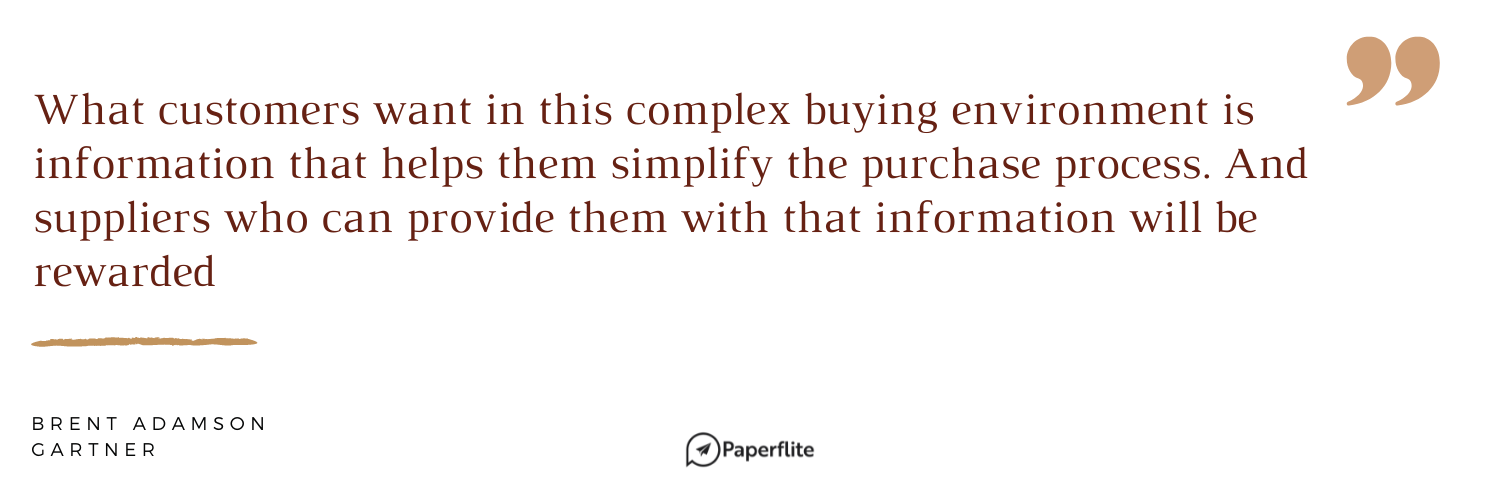
Buyer Enablement is any resource or tool that helps the buyer realise their challenges and simplifies the buying process and helps them make a purchase.
According to Gartner, Buyer Enablement is information or tools that support the buyer complete “activities” necessary to make a purchase.
A B2B buyer goes through the below set of buying activities before making a purchase:
1. Problem Identification
Oh no, there’s a pressing pain point that needs to be solved.
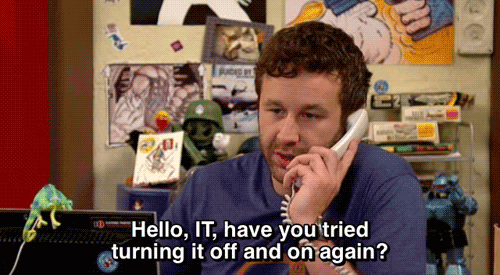
2. Solution Exploration
Asking Alexa/Siri or your trusted search engine if there’s anything that can fix this. Is it time to flash the Bat-Signal yet?
3. Requirements Building
Identifying the jobs-to-be-done by this purchase that we’re going to make.
4. Supplier Selection
Identifying the supplier that addresses the problems and meets all requirements (legal and procurement)
5. Solution Validation
Hold on, let’s double-check if this works?
6. Consensus Creation
Go around the stakeholder table and create consensus and get everyone on board.
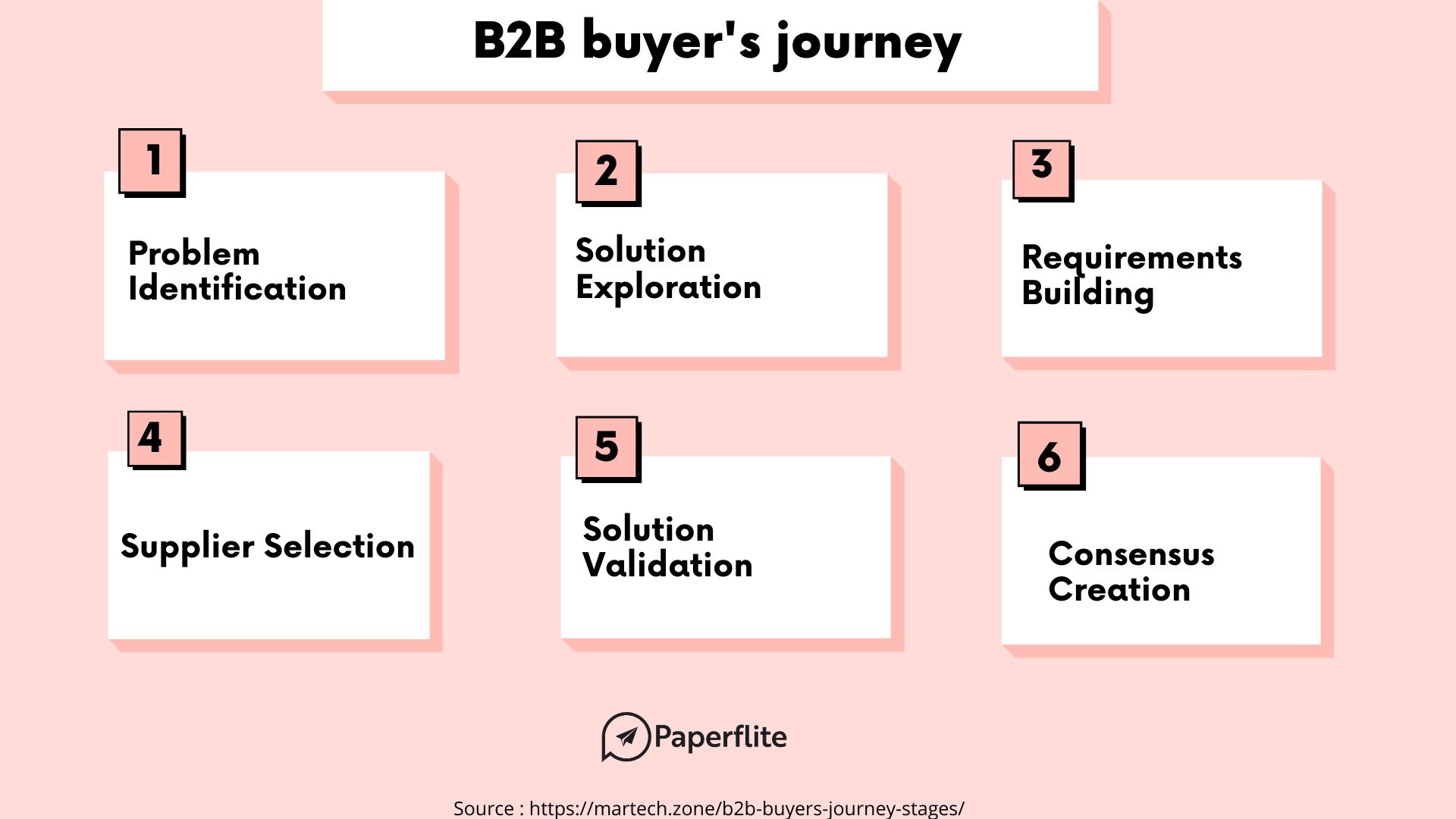
A study by HBR suggests that B2B buyers are, on average, 37% of the way through a purchase process by the time they reach the solution exploration stage and 57% of the way through the process before they engage with supplier sales reps.
So engaging buyers effectively at each of the above buying stages opens up a lot of opportunities. And content can be a great tool in driving effective engagement of the buyers.
Role of Content in Buyer Enablement
You’ve been meaning to get a new mobile device. Your trusty old phone has been heating up and is showing signs of slowing down. So you hop onto Amazon to check what’s available on the market. And your whole world comes crashing down.
There are 1000 new options available. You meddle with the filters thinking that will help you narrow it down but that only makes things worse. “Screw this”, you say and decide “trusty old phone” will do just fine.
But what if Amazon had a phone buying guide on its website? A tool that would ask for your requirements and your budget and would show you options based on your needs. Wouldn’t that make your life simpler?
Congratulations! You’ve had your first taste of buyer enablement content.
B2B buyers are spending more time researching purchases and expect more personalised attention from solution providers. In such contexts, your content can be your differentiator as it allows you to exist where your buyer is and deliver value at each touchpoint. With content, you can address the specific needs of your customer at each stage of their journey.
70% of B2B buyers said relevant content was an important part of their purchase decision
52% of B2B buyers said providing a better mix of content to help us through each stage made an impact on vendor selection
Gartner research found that customers who perceived the information they received from suppliers to help advance across their buying jobs were 2.8 times more likely to experience a high degree of purchase ease, and three times more likely to buy a bigger deal with less regret.
If the buyer has the right guidance and information at the right time, they are more likely to buy from you. If you're not investing in value-based, actionable and organic content to help your buyers make more informed decisions, you're costing your company at least a few thousand dollars.
Buyer Enablement Tools To Engage The Buyer Across The Buying Journey
Similar to the Amazon product buying guide, there’s plenty of other resources that brands use to make the purchasing decision easy for the buyer. For example, many organisations, on their websites, offer free ebooks or case studies highlighting how their solutions helped another customer.
What they’re doing essentially is trying to build trust among prospective buyers. Such tools go a long way in easing the buyer’s concerns and makes the buyer more likely to make the purchase
Here are some other examples of buyer enablement tools that you can use to enable buyers in different stages of their buying journey.
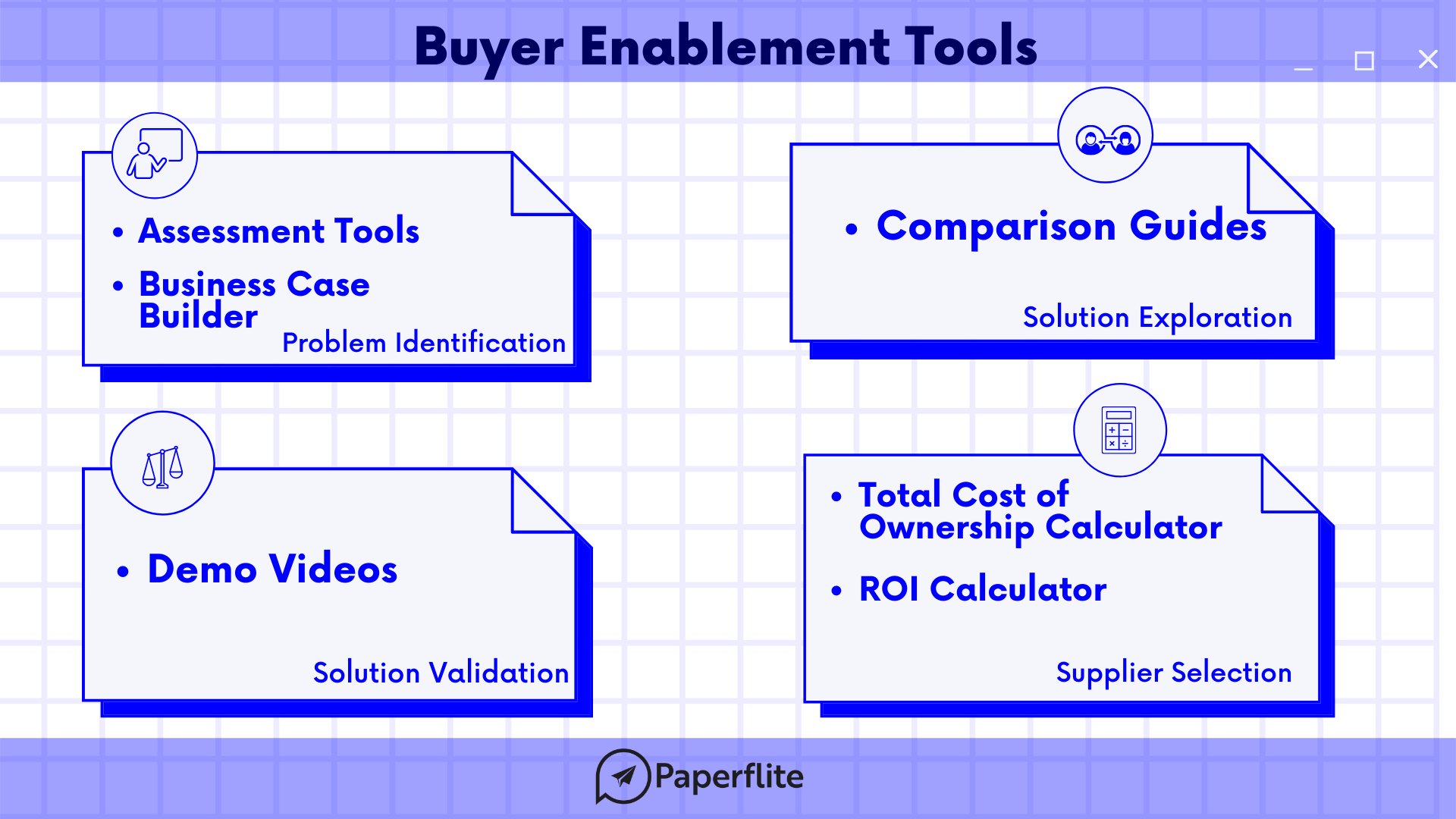
Buyer Enablement Content Guidelines
1. Accessible
If your content is a few million, exactly descriptive and complicated searches away, your audience is not going to find it. Here's where you ask your content editors and SEO experts to pull up and save the day.
2. Relevant
Your content must address the needs and pain points of your buyer. It should also speak the buyer’s language. If it’s jargon-filled and contains a lot of fluff, be prepared to get seen-zoned
3. Useful
Unimaginable and unprecedented amounts of value. And then a little more. Try to make everything you create actionable and goal-oriented.
4. Credible
Write facts from credible sources. And remember, opinions aren't facts. If the study was conducted among 18 participants, it wasn't a study, it was a group discussion.
5. Enables Decision Making
In B2B purchases, there are multiple decision-makers each with their own sources of information. Getting consensus becomes a huge bottleneck. Keep that in mind while creating your content so that you can appeal to each individual's opinions and answer their questions.
6. Differentiator
Your buyer enablement content should clearly state how you're different. Not better, just different. Show your audience your USP and let them choose. Sometimes, your USP can be the value you hand out for free.

Measuring Effectiveness of Buyer Enablement Content
In order to build effective content that enables buyers, sales & marketing teams need to understand how it helps buyers and at what stage during their buying journey.
Moreover, it is essential to track how your buyer enablement content is performing. Otherwise, it’s all a moot point because you’re just creating content black holes.
Here is a checklist to identify if your buyer enablement is working:
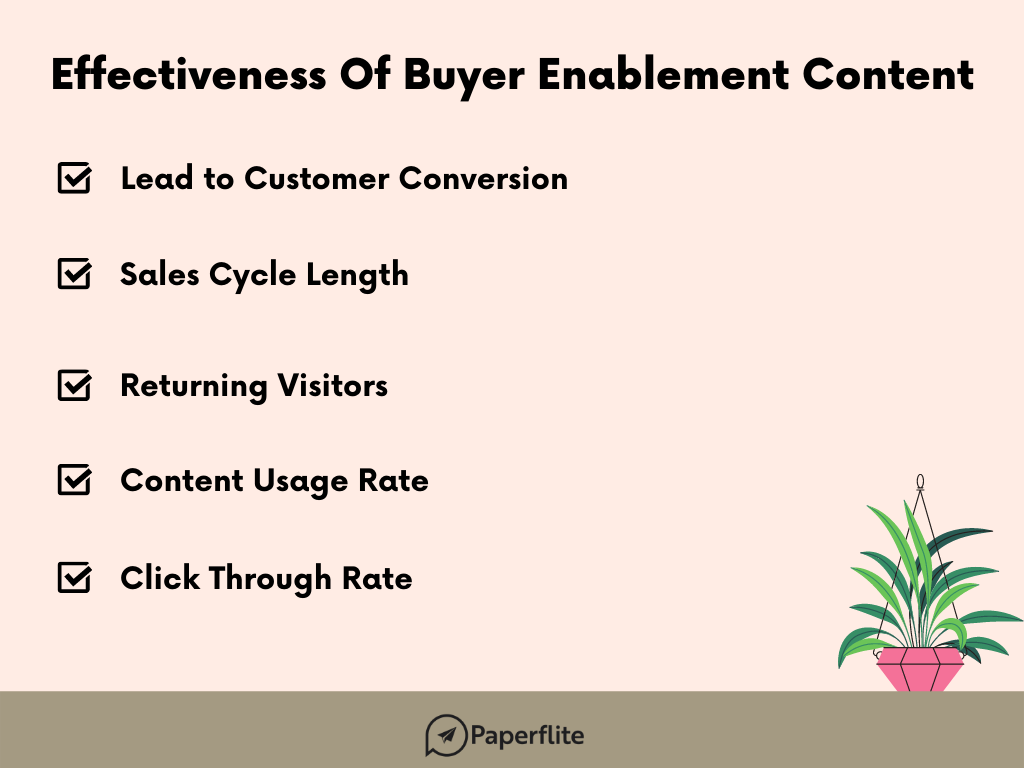
Looking Ahead
One key aspect of buyer enablement is nudging the buyer through the decision-making journey by providing relevant information at each step of the journey. And understanding how your buyer is engaging with your content will help you serve them relevant content at the right stage.
For buyer enablement content to be effective, your content also needs to be personalised to address the specific challenges of the buyer across all touchpoints in the journey.
76% of B2B buyers expected more personalised attention from providers based on the specific needs of the buyer.
One of the ways you could serve relevant and personalised content to your buyers is by making use of content experience platforms.
The Takeaway
The modern buyer is inundated with information that is more likely going to make them anxious and overwhelmed causing them to put off purchases altogether.
The B2B buyer completes a set of activities or “buying jobs” in the buying journey. And at each stage, providing them with personalised and relevant content is going to help them see through the chaos and arrive at a purchasing decision.
So your job is to only nudge the buyer with the relevant information at each stage and reduce friction along their buying journey.
Remember: nudge, not shove.
In summary:
